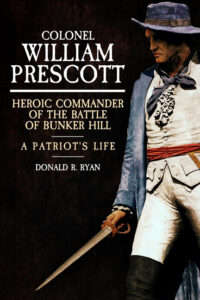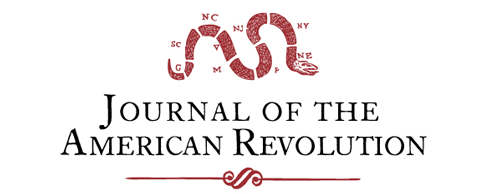BOOK REVIEW: Colonel William Prescott: Heroic Commander of the Battle of Bunker Hill by Donald R. Ryan. (Havertown, PA: Casemate, 2025) $34.95 hardcover.
Donald R. Ryan’s Colonel William Prescott: Heroic Commander of the Battle of Bunker Hill recounts the life a Massachusetts native who led his men in a courageous effort against a formidable British foe in one of the American Revolution’s early decisive battles.
 As much as this is a biography of Prescott, Ryan’s work is also a personal narrative woven throughout. He takes the reader on his journey to find out more about the man, a journey that started in 2020 during the coronavirus pandemic. Although Prescott is known for his heroic actions at Bunker Hill—accurately atop Breed’s Hill on the Charlestown Peninsula in Boston—on June 17, 1775, just months removed from the first shots of the war being fired at Lexington and Concord, the author took it upon himself to look at Prescott holistically.
As much as this is a biography of Prescott, Ryan’s work is also a personal narrative woven throughout. He takes the reader on his journey to find out more about the man, a journey that started in 2020 during the coronavirus pandemic. Although Prescott is known for his heroic actions at Bunker Hill—accurately atop Breed’s Hill on the Charlestown Peninsula in Boston—on June 17, 1775, just months removed from the first shots of the war being fired at Lexington and Concord, the author took it upon himself to look at Prescott holistically.
The battle was a relatively short affair, lasting only one day as Prescott and what remained of his forces quit the field after a third assault launched against them. Although chapters seven and eight give an account of the day and the aftermath, Ryan’s search also led him to discover Prescott’s roots, his role in Massachusetts government, specifically in his home of Pepperell, and any further action he saw in the war.
A Groton, Massachusetts native, Prescott was born February 20, 1726 on what was the frontier at that time. Ryan puts the family history back to Prescott’s great-great-grandfather, James Prescott, a gentlemen who provided protection to Queen Elizabeth should he be called upon. This was an honor according to Ryan and one that would have given him a respected status in his community. James’s son John left England—as many Puritans did—in 1638. By his death in 1683, the Prescott family was firmly based in New England. His youngest son Jonas was the one to settle in Groton, the birthplace of the colonel. Jonas’ youngest son Benjamin was William Prescott’s father. Like his father and grandfather, Ryan states that Bejamin was an “accomplished and active man.” The townsfolk thought him to be of “superior mental endowments and of commanding appearance.” William was the fourth child of Benjamin and Mary Prescott. He was the middle child of the family as three more siblings came after him, although not all would live into adulthood. Ryan states that life on the frontier growing up for Prescott was “fairly typical.” Throughout his life, work as a farmer would alternate with him taking up arms as a soldier. The American Revolution was not his first encounter with war; he served in both King George’s War at nineteen and later in the French and Indian War. In the latter conflict he made such an impression that the British government offered him a commission, which he turned down in favor of returning to farming and his roles in civic life.
In taking a greater role in his later home of Pepperell’s public affairs, Prescott came to embrace the cause for independence, being sent as a delegate to the Provincial Congress in Concord in 1774 while being appointed a colonel for a minutemen regiment. He would respond to the call for help as the British made their way Concord on April 19, 1775, but arrived too late to see action. The British were routed while making their retreat to Boston, harassed by 4,000 militiamen who saw action against them. Despite not seeing combat on that occasion, Bunker Hill was not far away.
He was chosen by Gen. Artemis Ward to lead a defense of Charlestown Peninsula despite being outranked by Gen. Israel Putnam. He was accompanied by Putnam and another commander, Richard Gridley, on that day along with Dr. Joseph Warren. A single statue, that of Prescott, stands atop Breed’s Hill. It was unveiled June 17, 1881, an honor Ryan states allows observers to conclude this was truly the man honored for that day.
It is telling that Prescott’s statue is the only one on the Bunker Hill battlefield, an obvious honor. To the citizens of Massachusetts and the associations formed to preserve the memories and achievements of the renowned battle, Prescott was their hero. John Stark, Israel Putnam, and Thomas Knowlton also played important roles as leaders of their respective troops during the fight, but they were out-of-staters and not the concern of the local citizens or societies. So the sole tribute went to Prescott, whose likeness has adorned the battlefield for near a century and a half.
This battle was not the only decisive moment of the war, or the period more broadly, that Prescott participated in. Through his investigation, Ryan places him at Gen. George Washington’s siege of Boston in 1776 that saw British forces depart from the city for Halifax, Nova Scotia. He would later command a garrison on Governor’s Island at the tip of Manhattan during the New York campaign which he would later withdrawal during Washington’s retreat, something the general commended him for. Investigating the later Battle of Saratoga, Ryan concluded Prescott did not play any significant part, possibly having never fired a shot, but was present for the surrender of Gen. John Burgoyne’s army. Years later, the colonel would also preside over Pepperell’s assembly to select a delegate for the Massachusetts convention to vote on ratifying the Constitution.
Despite the Battle of Bunker Hill not being a one-off for Prescott during the war, it was undoubtedly the defining moment of the military career of this Massachusetts farmer. Prescott did not shy away from a British assault and the reader gets the impression that his eagerness to serve extended to the rest of the conflict. He was not just a man of courage and bravery on the Charlestown Peninsula that day, but one who embodied those traits in a life of service militarily and civically.
Although some readers may find Ryan’s personal narrative off-putting, his journey does provide a sense of the various difficulties and hurdles overcome in the investigation. More than once, Ryan admits the sources simply could not be found to discover what Prescott was doing in some moments, or what he was thinking or feeling about a particular subject. The man was a farmer and soldier, not a writer or intellectual. He did not leave behind a treasure trove of source material which Ryan could use as the basis of his study. There is a typographical error on page 201 when Ryan states that in 1743, a Bunker Hill dedication was attended by over 100,000 people including President John Tyler, but it can be easily recognized by a reader who has a basic knowledge of the presidency and the period. Overall, Colonel William Prescott belongs with an increasingly larger and appreciated number of biographies, giving the lesser-known heroes of this war their due.
PLEASE CONSIDER PURCHASING THIS BOOK FROM AMAZON IN HARDCOVER OR KINDLE.
(As an Amazon Associate, JAR earns from qualifying purchases. This helps toward providing our content free of charge.)





Recent Articles
The Evolution of the American Declaration of Independence
The Deadliest Seconds of the War
Entangled Alliances: Racialized Freedom and Atlantic Diplomacy During the American Revolution
Recent Comments
"The Deadliest Seconds of..."
A very good article. Nicely done. I noticed with interest that the...
"The Deadliest Seconds of..."
Since the main purpose for the ships of the Continental Navy was...
"A Curious Agreement Among..."
Mr. Ness, I would love to have a copy of that list....